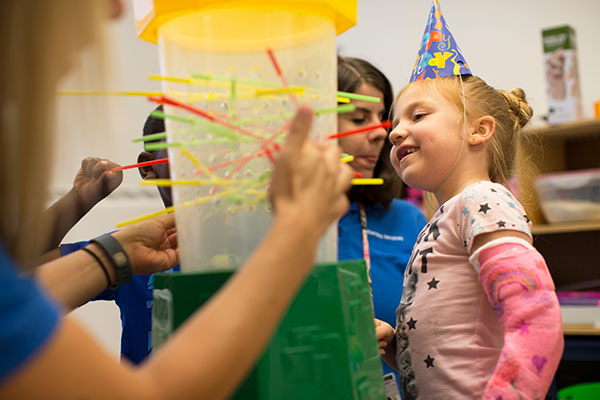Overview

Cleveland Clinic Children’s Upper Extremity Clinic provides collaborative multidisciplinary care for children from birth to age 20 with conditions that result in upper extremity motor dysfunction.
Our goal is to help the child maximize functional use of the affected arm or hand using a variety of therapeutic approaches. Individualized assessments are completed and treatment programs are designed for each child.
Upper Extremity Clinic is a collaborative multidisciplinary clinic for children from birth to age 20 with conditions that result in upper extremity motor dysfunction. The goal is to help children maximize functional use of their affected arm or hand using a variety of therapeutic approaches. UE clinic team includes a physiatrist, occupational therapist, and hand surgeon when indicated. Consultations with physical therapists are available if needed.
The team collaboratively develops individualized treatment recommendations unique to each child. These may include referral for outpatient therapy and/ or the Constraint Induced Movement Therapy (CIMT) program, spasticity management, casting or splinting, family education, and home programming as indicated.
The team collaboratively develops individualized treatment recommendations unique to each child’s circumstances. These may include:
Therapy options
- Outpatient occupational/physical therapy to increase functional ability and quality of life.
- Constraint-induced movement therapy (CIMT) to improve spontaneous movement quality and increase overall functional use of the affected upper extremity.
- Casts, splints and braces/orthotics to hold the elbow, wrist or hand in certain positions that are more functional or to prevent progression of joint contracture or stiffness that is restricting normal movement.
Medical options
- Anti-spasticity medication to relax muscles and increase function.
- Botox injections or nerve blocks to weaken selective muscles and allow for the child to further straighten an arm or hand enough to practice functions, such as reaching and grabbing. This allows for functional practice, and it also provides opportunity to strengthen the nerve connections between the muscles and the brain centers that control those muscles.
Surgery options
- Tendon lengthening.
- Tendon transfer.
- Bone fusion.
- Nerve graft.
- Scar tissue removal.
What We Treat
Conditions affecting the function of hands and arms may present at birth or may occur later due to injury. At Cleveland Clinic Children's, our team can address upper extremity conditions that may have resulted from:
- Brachial plexus palsy.
- Cerebral palsy.
- Congenital deformities.
- Hand or arm fractures.
- Hemiplegia.
- Nerve or tendon trauma.
- Spinal cord injury.
- Stroke.
- Traumatic brain injury.
Our Team
Our team has a long history of working with children to maximize upper extremity function. Our collaborative team approach enables us to develop a comprehensive treatment plan that is tailored to meet the needs of each child’s circumstances. Your child's care team may include:
Pediatric Rehabilitation Medicine (Pediatric Physiatrists)
Occupational Therapists
- Jessie Stricker, OTR/L
- Angela Rice, OTR/L
- Julie Brizes, OTR/L
- Sue Gara, OTR/L
Physical Therapists
PT consultation available when indicated.
Appointments
To schedule an appointment with the Cleveland Clinic Children’s Upper Extremity Clinic, please call 216.448.6110.

